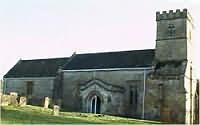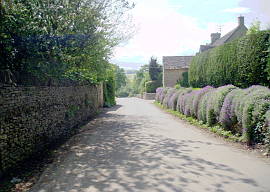
The Bannisters remained owners of the Turkdean manor through the 17th century and were among the longer-lasting families to own the estate, but they sold their Turkdean and Hazleton lands to the Waller family (from Beaconsfield) in 1725 who also acquired land in Farmington which they retained when they sold their Turkdean land to the Willan family in 1799.
In Saxon times, in the days of King Edward the Confessor, Turkdean Manor was held by Osgot, then Siward and then Goisfrid and as the Domesday Book records William the Conqueror, shortly after 1066 gave it to Robert D’Oilgi. Subsequent owners were in approximately these times: 1202 Robert de Tormion, 1274 John Langley, 1399 Walter Langley, 1428 John Ralegh ? Thomas Ralegh? Walter Ralegh, then the College at Westbury on Trym near Bristol.
Westbury was once 692 in the diocese of Worcester and the church in Westbury was founded in 716/7. By 961 was found the first settlement of Benedictine monks. In about 1544 (at the time of the dissolution of the monastries) the Manor of Turkdean passed to Ralph (or Rafe) Sadler. In 1907 the college and its property were given to the National Trust and the site became a place for housing elderly people.
In 1608 Thomas Bannister became the owner (the reference 1604 (next page) would seem to be incorrect). Sir Robert Atkyns, in a book he published in 1786 ‘The Ancient and Present State of Gloucestershire’ printed a number of Coats of Arms of various notable county families including the Bannisters.
From ecclesiastical records between 1611 and 1666 . There were 12 Bannisters christened at Turkdean church, 3 marriages between 1665 and 1710 and 10 burials between 1604? and 1720. In the South East corner of the nave are several tombstones in the floor.
It has been pointed out that Robert D’Oiligi fought at Hastings serving William the Conqueror. A member of the Bannister family also did. In those days the name was spelt Banastre. The family became one of the most important in England after the Conquest; the most distinguished member probably being Sir Thomas Banastre K.G. He fought in the Holy Land, France and Spain and was one of the founders of the Order of Knights of the Garter in 1348 when Edward III was King of England. This Order rates first amongst the European Orders of Chivalry except later for the Victoria Cross.
The first Banastre in this country is recorded on the Role of Battle Abbey as he was one of the principal followers of William I. For his services he was granted land at Englefield in the county of Flint where he built a castle at Prestatyn. The heads of the family remained there till the 12th Century when Owen Gwyneth overpowered the Normans and the Banastres retreated to Lancashire. Prestatyn castle was destroyed; today a mound marks the site.
Since then the family has spread over many parts of England. The Latin form of the name is Balneator hence the inference that it might be a title of office in connection with the Ceremony of the Bath used when conferring Knighthood. In the Glossary of Ducenage it is stated that Banatre, Banaste, Benate, words used in France answered the medieval Latin Bonasta, Banastrum or provincially Banaste – meaning basket or creel which when used in pairs could be slung over a donkey’s back as dossers or paniers.
Alternatively, Banatre could be a corruption of the Italian Balastro (Latin Balstarius) meaning – one who manipulates the balastra or machinery for hurling stones against a fortification. From Balastro the name changed to Banastre and was later altered to Balister (the hand rail of a staircase) also becoming Bannister.
It is believed that Turkdean Manor was built in about 1558. William Banastre was the first Lord of the Manor of his family in the reign of Hames I (1603-25) and he died in 1604 (1608) and was succeeded by his son Thomas who died in1633. His brother George inherited; followed by George’s son William and William’s son Sir William who died in 1720. He was buried ‘in woollen’ in Turkdean church as were many other members of the family. Sir William was a barrister taking his Degree of Coif in 1706 and becoming a judge in South Wales, he was
created a Baron of Exchequer and dubbed a Knight in 1713. His wife’s name was Elizabeth and being a Knight’s widow styled herself Dame Elizabeth, James I permitted this. It is not quite certain when the family left Turkdean.
Turkdean
Turkdean is a small village with an ancient history.
The true extent of this history was demonstrated by the archaeological work undertaken by 'Time Team' for their Bank Holiday weekend dig in August 1997. This represented the first time that an archaeological dig was broadcast live and against the clock.
This small village is pleasantly sited on a hillside, with the hamlet of lower dean in the valley below, the two being joined both by a road leading down through a magnificent avenue of beech trees and also by a shorter, but steep little path.
 The Norman church, situated in a large church yard bordered by chestnut trees, has some interesting items of early sculpture built into the lower stages of its tower.There is also a blocked-up Norman doorway in the south wall of the chancel.
The Norman church, situated in a large church yard bordered by chestnut trees, has some interesting items of early sculpture built into the lower stages of its tower.There is also a blocked-up Norman doorway in the south wall of the chancel.
The perpendicular north doorway is sheltered by a porch of the same period, and opens into an interior which contains a Norman pulpit.




